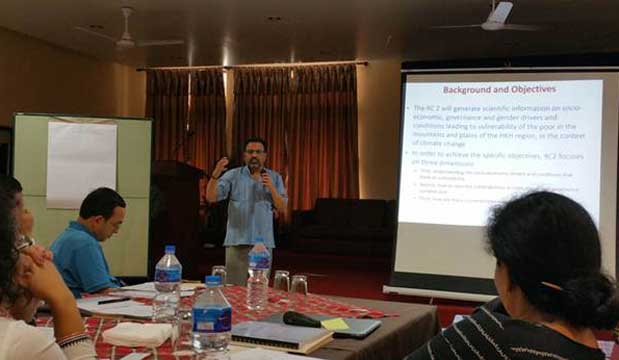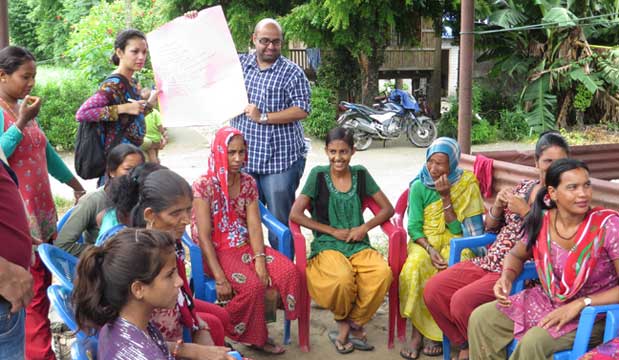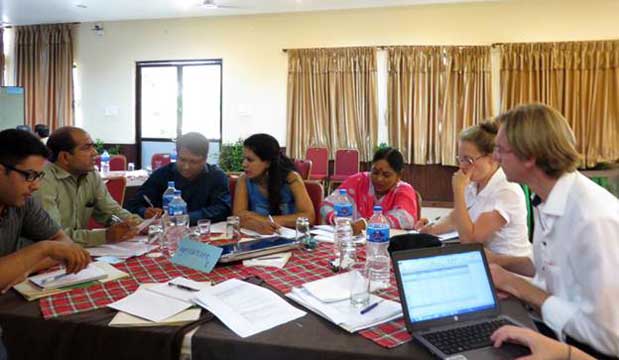A HI-AWARE team comprising researchers from consortium member organisations and partner organisations met in Chitwan, Nepal, from July 4-10, 2015 to discuss and test tools and methodologies for conducting participatory research on socio-economic and gender drivers and conditions giving rising to vulnerability to climate change (RC2) and on critical moments and adaptation turning points (RC4).
 Dr KS Murali, Senior Programme Officer-IDRC, providing an overview of research component 2.
Dr KS Murali, Senior Programme Officer-IDRC, providing an overview of research component 2.
Photo credit : Aneel Piryani/ICIMOD
Navarun Varma, researcher with TERI, presented a conceptual framework for Research Component 2 (RC2), which looks at how factors of social wellbeing interact with ecosystem changes to shape differential vulnerabilities, including subjective and relational aspects of vulnerability and resilience. Djiwen Mallick, researcher with BCAS, on the other hand, underscored the importance of gender perspectives in participatory research to understand differential vulnerabilities of different sets of peoples, including relations between men and women in the context of climate change. Djiwen emphasised that researchers must devote sufficient time in the field to break down researcher-participant hierarchies, and to develop trust and rapport with the communities among whom they conduct research.
Philippus Wester, Principal Investigator for HI-AWARE, reminded all that HI-AWARE won’t be duplicating a vulnerability assessment study in HI-AWARE study sites, since it is already well established that sectors / people are vulnerable to climate change. The challenge, he said, was to create a common methodological framework.
Next, about six tools of participatory research – hazard mapping, social ranking, trend analysis, vulnerability matrix, seasonality, and gendered vulnerability – were discussed using a gender lens in relation to various sectors.
In the first phase, the workshop participants were divided into three teams (A, B, and C) and each team was assigned a tool to test in a community setting. Team A tested the hazard-mapping tool in their gender-disaggregated focused group discussion with a community in Dadreni; Team B used the trend-analysis tool to discuss various drivers of climate change and identified floods, droughts and heat stress as major hazards affecting Chitwan; and Team C used the seasonality tool to discuss with farmers changes observed in rainfall pattern in relation to the agriculture calendar for wheat, linseed, buckwheat and certain vegetables.
 HI-AWARE researchers interacting with community stakeholders in Chitwan.
HI-AWARE researchers interacting with community stakeholders in Chitwan.
Photo credit : Aneel Piryani/ICIMOD
In the second phase, the workshop participants were divided into two teams (A and B) and assigned social-wellbeing ranking and vulnerability-matrix tools for testing respectively. Team A tested the social-wellbeing ranking tool on the Gyaneshwor Community Forestry User Group in Mangalpur to assess their relative resilience to climate change; Team B used the vulnerability matrix tool to understand the context of hazards in relation to different sectors such as agriculture, livestock, the wage-labour market and eco-tourism. Flood, drought and heat stress were identified as hazards with highly disruptive impacts on these sectors.
While taking stock of the efficacy of the participatory research tools tested, Team A found the hazard mapping and social ranking tools to be useful and easy to use. Team B made a case for giving something back to the community in return for taking part in HI-AWARE research and said that climate-trend analysis and vulnerability-matrix tools should be considered for RC2, even though it might not be easy to attribute impacts of hazards sector-wise. Team C recommended applying the seasonality tool by breaking the season into smaller timeframes such as weeks – not just months – to understand even slight changes in the crop calendars of various crops, and argued for an in-depth study of traditional/local and hybrid crop varieties during their crop cycles. Dwijen Mallick concluded the review session by underscoring how guiding questions, which were missing in field testing, can increase the applicability of the tools used, and how adhering to research ethics can lead to a more nuanced and thorough field study.
Anne Marie Groot, researcher affiliated with Alterra, next presented the concept of Critical Moment (CM), focusing on the temporal and severity dimensions of vulnerability – the time of the year people/sectors are most vulnerable to climate change and the extent of damage and loss incurred. Then she introduced the methodology to assess CM, which includes steps such as selecting a climate hazard, stakeholders and sector; identifying critical moments; understanding future climatic and other changes that affect CM, not to mention the kind of adaptation measures that are needed to reduce the impact of CM.
 Dr Anne Marie Groot introducing the Critical Moment methodology
Dr Anne Marie Groot introducing the Critical Moment methodology
Photo credit : Aneel Piryani/ICIMOD
She then divided the workshop participants into three groups – Health Group, Agriculture Group and Tourism Group – and sent them to pre-identified communities to test the CM methodology.
The Tourism Group interviewed a mix of hoteliers, tour operators and guides and learnt that ‘safari tourism’ often took a dive during the monsoon (May to July) due to heavy monsoon rain; also they had to turn on generators to cool the guest rooms in summer, which increased their operational costs by up to 30 percent; and in winter (November to January), load-shedding posed a challenge as the demand for heating was highest then. It was generally agreed that the rise in temperatures also tended to lead to a diversion of tourists to cooler destinations like Pokhara. The hoteliers also said that the floods in the Rapti and Narayani rivers in the past had disrupted their businesses, and said the rise in water levels in the nearby rivers during the monsoon season was a cause of concern. Their major concern, however, was related to energy (the availability of electricity) and transportation, the availability of which would allow them to not only attract but also retain clients even in the leanest season.
The Agriculture Group, in their discussions with a mix of commercial and subsistence farmers, leant that the most crucial period for paddy plantation was June-July, when monsoon rain is expected, and for paddy cultivation it is September to October when there must not be any rain, lest the farmers suffer ‘loss and damage’. Delay in monsoon rain beyond the expected period tended to result in up to 25 percent loss in terms of crop yield.
 A research group discussing critical moments in the agriculture sector of Chitwan.
A research group discussing critical moments in the agriculture sector of Chitwan.
Photo credit : Aneel Piryani/ICIMOD
The Health Group, in their discussions with a health care team from Sahaj Community Hospital in Chitwan, learnt that the prevalence of diseases varied with the season of the year. Diarrhoea, vomiting and skin fever were found to be common in summer, whereas respiratory illnesses were found to be common in winter, mostly among young kids and the elderly. They all agreed that dengue is the most severe disease in the monsoon season (June-August), when the implementation of the ‘detect and destroy dengue’ mission at the district level yielded the highest level of dividends in terms of controlling the spread of the disease.
The field-testing of the CM methodology and the follow-up review provided the HI-AWARE research team responsible for Research Component 4 (RC4) with an understanding of the value this methodology brings to their field-research work as well as its limitations, such as the following:
- a ‘critical moment’ is experienced differently by different stakeholders as it is also dependent on the nature of activities they undertake. This then poses a challenge to conceptualising CM in simplistic and unilateral terms;
- CMs are dynamic – you cannot take just one moment, as it changes with seasons and climate change. Because of this uncertainty, defining CM in a narrow sense becomes very difficult;
- there may be an ethical issue in prioritising CM, especially if a bigger event occurs and the focus of practitioners is on something else and resources are directed towards that; and
- if people are experiencing CM now, will they not already be acting on it, thereby reducing the criticality of the moment?
- challenges of attribution – basically, linking health problems to climate change, or tracking impacts of a particular hazard sector-wise.
